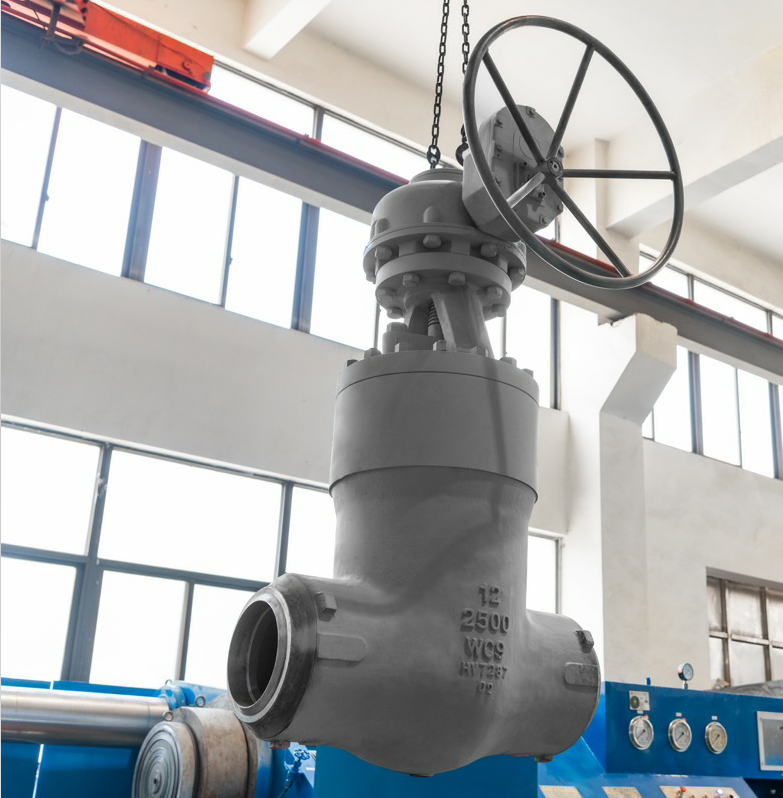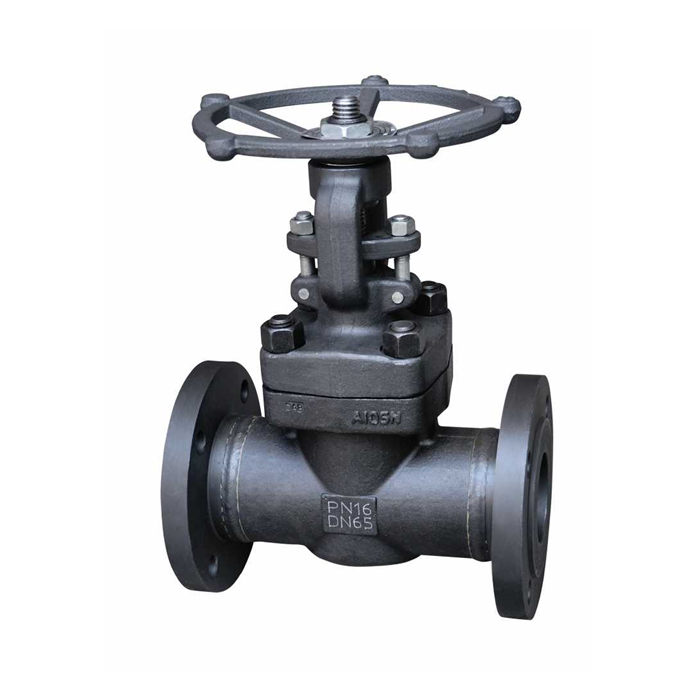Table of Contents
ToggleGate valves are one of the most widespread and versatile control valves used in waterworks, power, wastewater, and pipeline installations. New installations, maintenance, or repair works often necessitate these valves to isolate specific areas or reroute fluid flow throughout a network.
Selecting the ideal valve for your application is critical, as it will have a substantial impact on its usage and performance. A well-chosen model helps avoid future problems like leakage or subpar performance, so it is wise to carefully consider your industrial requirements and specifications before purchasing anything.
What is a Gate Valve?
A gate valve is an adjustable linear motion valve used in various applications. Its primary purpose is to stop the fluid flow by positioning a flat closure element called a gate inside the valve.
Valves come in a variety of materials and can be specified by organizations creating standards for specific environments. Common choices include cast iron, stainless steel, forged steel, bronze, and plastic.
Gate valves consist of three primary parts: a hand wheel, stem, and bonnet. The handwheel moves the stem to open or close the gate while the bonnet secures both parts together.
Types Of Gate Valves
A variety of gate valves are available to meet a variety of applications.
- Parallel Gate Valves
Parallel Gate Valves are made of solid metal and used to regulate fluid flow in pipelines. They can be operated manually with pneumatic actuators or electric motors.
The basic design of a parallel slide gate valve is as follows:
A gate disc is placed between two seats and controlled by a stem and hand wheel that moves up and down at right angles to the direction of fluid flow.
Parallel slide gate valves come in various sizes and types, including flanged end, threaded end, and forged. They can be produced using various manufacturing processes such as casting, forging, or machining.
- Wedge-Shaped Gate Valves
Wedge-shaped Gate Valves function by using a wedge disc to start or stop fluid flow. They can be operated manually, electrically, or pneumatically.
These valves come in various sizes and can be utilized for a variety of applications. They are constructed from materials such as stainless steel or hard alloys.
Split wedge designs provide flexible seating on both the suction side and discharge side of a valve, which is especially helpful in applications with temperature fluctuations since piping and valve dimensions change accordingly.
- Metal-Seated Gate Valve
When selecting a gate valve, one of the primary considerations should be its sealing surface material. Depending on whether your fluid is corrosive or contains abrasive particles, this seat material may be necessary.
Industrial gate valves typically consist of stainless steel, cast iron, and ductile iron due to their durability and resistance to corrosion and abrasion. Furthermore, these materials can withstand temperature variations of up to 1500oF (400degF).
- Resilient Seated Gate Valves
Resilient seat gate valves are commonly used on water supply pipelines, municipal drainage projects, firefighting pipeline projects, and industrial pipelines that handle slightly non-corrosive liquids and gases.
Resistant seated gate valves offer greater resistance to pressure and temperature changes than metal-seated ones and can be made of various materials like plastic or rubber.
This type features a rubber component that absorbs and flushes impurities as the valve closes, restoring its surface back to its original shape when opened again.
- Rising Stem Designed Gate Valves
A Rising Stem Gate Valve is designed with an Outside Screw and Yoke (OS&Y) design, featuring threads on the actuation side that rise together when opened or closed. This provides a visual indicator of valve position, is easily lubricated, and is suitable for manual activation.
Rising stem gate valves are typically used in underground or aboveground installations. They come in various designs, such as line blind, t-shape, and angular (90 Degree) shapes.
- Non-Rising Stem Gate Valves
A non-rising gate valve features a screwed stem inside the valve body which rotates with gate movement when viewed from the outside. This design is ideal when monitoring the operation of the valve and is typically installed on aboveground installations for added convenience.
A Non-Rising Stem Designed Gate Valve is a type of gate valve with no moving stem as it opens and closes. This design saves installation space and maintenance expenses by eliminating the need to raise and lower the valve stem as necessary.
- Other Gate Valve Types
Many different types of gate valves are employed in pipeline and workplace applications. To make selecting the correct one easier, they have been organized into various categories for convenience.
Solid Wedge Valves: Solid wedge valves are a widely-used gate valve type used in pipe installations for liquids and gases. Their robust construction allows them to be fitted into various pipe positions with ease.
Split Wedge Valves: These more specialized wedge valves are often used in applications involving corrosives or slurry fluids. The disks on these wedges have been tapered at one end to cut and move through thicker fluids when closing.
Pneumatic Operation: These valves are less common, using a pneumatic actuator instead of a handwheel to open or close. Compressed airlifts the stem when opening the valve while compressed air lowers it when closing.
Gate Valve Advantages and Disadvantages
Gate valves are used to regulate the flow of liquids and gases. They come in various sizes and materials, making them suitable for a range of applications. Let’s take a look at a few of the advantages and disadvantages of gate valves.
Advantages
- Easy To Operate
Gate valves are a commonly-used type of valve in various applications due to their ease of operation, durability, and easy installation. They require minimal upkeep and, with proper care, can last for years.
- They Are Durable & Versatile
They are robust and have a long lifespan. Furthermore, they require minimal installation effort, plus repairs can easily be made if any damage does occur. Another advantage of a gate valves is their versatility; they can be installed in various positions, making them perfect for pipeline installations. Furthermore, these valves are built to withstand extreme temperatures and pressures.
- Better Sealing Operation
In general, gate valves are effective at controlling liquid flow within a system. Furthermore, they are constructed from durable materials that can withstand extreme temperatures and pressures – making them an ideal choice for industrial applications.
- User-friendly
Gate valves offer the main advantage of being user-friendly. This makes them suitable for many applications, such as chemical plants, water treatment facilities, and other industrial settings. Furthermore, gate valves are cost-effective solutions for various fluids.
- Have Multiple Applications
Gate valves are one of the most frequently and widely utilized types of valves in the industry. Their design makes them simple to operate, and they can be utilized in a range of applications. Gate valves are used to control and regulate the flow of fluids. They’re ideal for applications involving slurries or viscous liquids. They can be utilized as venting valves and in low vacuum systems.
- Excellent for Industrial Operations
Gate valves are an excellent option for industrial applications due to their durability, long lifespan, and precision control of liquid flow. But before making a final decision on which gate valve best suits your needs, be sure to evaluate both its pros and cons so you can make an informed decision.
Disadvantages
- Slow Opening And Closing Time
One of the drawbacks of gate valves is their slow opening and closing time. This can be an issue if you need to quickly stop water or other fluid flow. Furthermore, these components are highly susceptible to corrosion which could cause leaks and other issues.
- They Clog Easily
One of the drawbacks of a gate valve is its tendency to clog easily. This makes them unsuitable for certain applications requiring high levels of cleanliness or optimal hygiene conditions. Furthermore, gate valves are more vulnerable to erosion damage and scratches on their sealing faces, decreasing their durability and service life significantly.
How Does the Gate Valve Function?
A gate valve is an industrial linear type that can be used to restrict or permit the flow of media. They’re also often employed as shut-off valves during troubleshooting and pipe-cleaning tasks.
A handwheel or actuator moves up and down to open and close the gate disc. The stem, which connects to this handwheel or actuator, guides its position relative to the gate disc. A gate valve consists of three main parts: the body, stem, and bonnet. Understanding each component is essential for understanding how it operates.
Gate Valve Parts
Gate valves are a type of linear industrial valve used to either stop or allow liquid flow. They function by moving a wedge-shaped disc upwards to open or downwards to close.
- The Handwheel
The handwheel is the driving device responsible for opening and closing valves. There are various types of handwheels available, and understanding their mechanism will help you select the best one.
- The Bonnet
The bonnet is a pressure-retaining part of the valve that provides protection to its internal components. It has been designed to withstand operating pressure and the corrosive effects of fluid exposure.
- The Body
Gate valves are slow-opening, multi-turn valves that require more than 360 degrees to fully open and close. This helps avoid water hammer effects as well as disk and seat damage from occurring.
- The Disc
A gate valve’s disc is an essential element of its operation. As the only part in direct contact with media, it needs to be strong and flexible enough to withstand repeated abuse.
Disc valves come in a range of types, depending on their function and application. Common choices include split wedge, flexible, and solid wedge valves.
- The Seat
The seat of a valve body may be integral or constructed as part of a seat ring system. Either threading onto the body or pressing in place and then welding ensures secure seating.
Conclusion
Situated in Zhejiang, China, Xintai Valve is one of the leading manufacturers of valve products worldwide. Their cast steel globe valve is popularly used in many applications due to its low resistance and tight closing mechanism.
They offer a comprehensive selection of specialized valves, such as expanding gate valves, ram and annular blow-out preventers, pulse dampers, and FC-type valves. Their products are engineered to solve difficult piping issues and ensure efficient operations across various industries.











